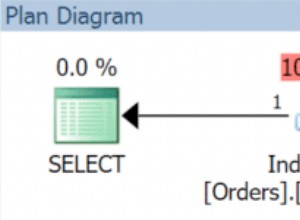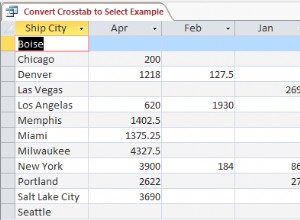Ecco come appaiono le possibili sovrapposizioni, dove 'A' è l'intervallo di "riferimento". Nota che la query di seguito (molto, molto al di sotto) non dà lo stesso risultato di nessuna delle risposte ancora pubblicate.
-- A |------|
-- B |-|
-- C |---|
-- D |---|
-- E |---|
-- F |---|
-- G |---|
-- H |---|
-- I |---|
"B" non si sovrappone affatto ad "A". La "C" lo appoggia. {"D", "E", "F", "G"} si sovrappone. La "H" lo appoggia. "I" non si sovrappone affatto.
create table calls_nov (
sid varchar(5) primary key,
starttime timestamp not null,
endtime timestamp not null
);
insert into calls_nov values
('A', '2012-01-04 08:00:00', '2012-01-04 08:00:10'),
('B', '2012-01-04 07:50:00', '2012-01-04 07:50:03'),
('C', '2012-01-04 07:59:57', '2012-01-04 08:00:00'),
('D', '2012-01-04 07:59:57', '2012-01-04 08:00:03'),
('E', '2012-01-04 08:00:01', '2012-01-04 08:00:04'),
('F', '2012-01-04 08:00:07', '2012-01-04 08:00:10'),
('G', '2012-01-04 08:00:07', '2012-01-04 08:00:13'),
('H', '2012-01-04 08:00:10', '2012-01-04 08:00:13'),
('I', '2012-01-04 08:00:15', '2012-01-04 08:00:18');
Puoi vedere tutti gli intervalli sovrapposti in questo modo. (Ho usato to_char() per semplificare la visualizzazione di tutti i dati. Puoi ometterlo in produzione.)
select t1.sid, to_char(t1.starttime, 'HH12:MI:SS'),
to_char(t1.endtime, 'HH12:MI:SS'),
t2.sid, to_char(t2.starttime, 'HH12:MI:SS'),
to_char(t2.endtime, 'HH12:MI:SS')
from calls_nov t1
inner join calls_nov t2 on (t2.starttime, t2.endtime)
overlaps (t1.starttime, t1.endtime)
order by t1.sid, t2.sid;
A 08:00:00 08:00:10 A 08:00:00 08:00:10
A 08:00:00 08:00:10 D 07:59:57 08:00:03
A 08:00:00 08:00:10 E 08:00:01 08:00:04
A 08:00:00 08:00:10 F 08:00:07 08:00:10
A 08:00:00 08:00:10 G 08:00:07 08:00:13
B 07:50:00 07:50:03 B 07:50:00 07:50:03
C 07:59:57 08:00:00 C 07:59:57 08:00:00
C 07:59:57 08:00:00 D 07:59:57 08:00:03
D 07:59:57 08:00:03 A 08:00:00 08:00:10
D 07:59:57 08:00:03 C 07:59:57 08:00:00
D 07:59:57 08:00:03 D 07:59:57 08:00:03
D 07:59:57 08:00:03 E 08:00:01 08:00:04
E 08:00:01 08:00:04 A 08:00:00 08:00:10
E 08:00:01 08:00:04 D 07:59:57 08:00:03
E 08:00:01 08:00:04 E 08:00:01 08:00:04
F 08:00:07 08:00:10 A 08:00:00 08:00:10
F 08:00:07 08:00:10 F 08:00:07 08:00:10
F 08:00:07 08:00:10 G 08:00:07 08:00:13
G 08:00:07 08:00:13 A 08:00:00 08:00:10
G 08:00:07 08:00:13 F 08:00:07 08:00:10
G 08:00:07 08:00:13 G 08:00:07 08:00:13
G 08:00:07 08:00:13 H 08:00:10 08:00:13
H 08:00:10 08:00:13 G 08:00:07 08:00:13
H 08:00:10 08:00:13 H 08:00:10 08:00:13
I 08:00:15 08:00:18 I 08:00:15 08:00:18
Puoi vedere da questa tabella che "A" dovrebbe contare 5, incluso se stesso. "B" dovrebbe contare 1; si sovrappone a se stesso, ma nessun altro intervallo si sovrappone. Sembra la cosa giusta da fare.
Il conteggio è semplice, ma funziona come una tartaruga rotta. Questo perché valutare una sovrapposizione richiede molto lavoro.
select t1.sid, count(t2.sid) as num_concurrent
from calls_nov t1
inner join calls_nov t2 on (t2.starttime, t2.endtime)
overlaps (t1.starttime, t1.endtime)
group by t1.sid
order by num_concurrent desc;
A 5
D 4
G 4
E 3
F 3
H 2
C 2
I 1
B 1
Per ottenere prestazioni migliori, puoi utilizzare la "tabella" sopra in un'espressione di tabella comune e contare in base a quello .
with interval_table as (
select t1.sid as sid_1, t1.starttime, t1.endtime,
t2.sid as sid_2, t2.starttime, t2.endtime
from calls_nov t1
inner join calls_nov t2 on (t2.starttime, t2.endtime)
overlaps (t1.starttime, t1.endtime)
order by t1.sid, t2.sid
)
select sid_1, count(sid_2) as num_concurrent
from interval_table
group by sid_1
order by num_concurrent desc;




